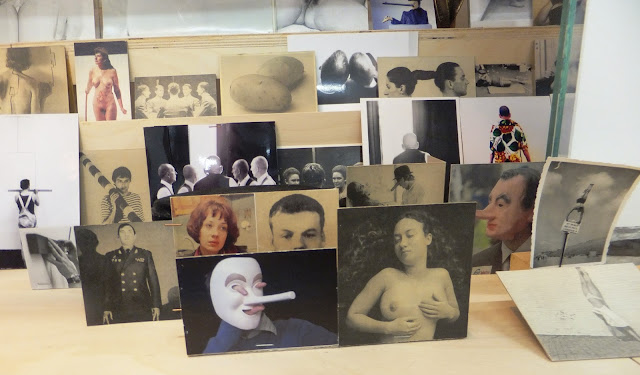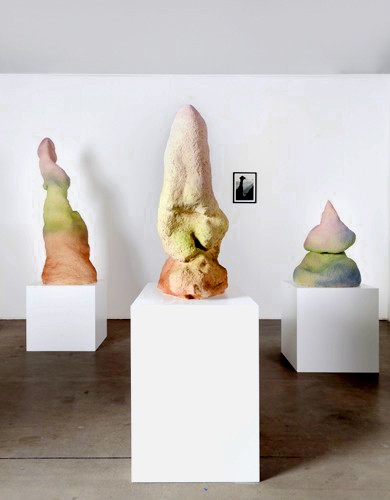 |
| Kelly Richardson: The Erudition (detail of video still) |
London’s art
scene is too rich to take in at the moment: you can go historically for high
quality surveys of the Ice Age (British Museum) to Barocci (National Gallery),
Murillo (Dulwich & the Wallace Collection), Manet (Royal
Academy), the Newlyn School (Two Temple Place), early Picasso (Courtald),
Schwitters (Tate Britain), Morandi (Estorick), Man Ray (NPG), Ansel Adams
(Greenwich), Elizabeth Frink (pretty comprehensive even if Outer London, you
might say, in Woking), Bruce Nauman (Hauser & Wirth), Rosemary Trockel
(Serpentine) and Gerard Byrne (Whitechapel), not to mention the big shows I’ve
picked below. I'd add Byrne to Kelly Richardson (Edel Assanti and the Towner, Eastbourne), Shaun Gladwell (de la warr Bexhill - how big can London get?), Lichtenstein, Kolářová and The Barbican as my must-see retrospectives, the first three of which I'm writing about elsewhere - for Border Crossings, Photomonitor and Art Monthly. But there is as ever plenty worth seeing in smaller galleries,
too, several of which explore space to considerable effect… Richardson's half-real half-virtual spaces are at one with that theme.
--------------------------
--------------------------
Candida Höfer : A Return to Italy @ Ben Brown Fine Arts, 12 Brook's Mews - Mayfair
 |
| Teatro Scientifico Bibiena Mantova |
Thirteen new large format photographs of interiors body best-known female
representative of the Düsseldorf School see her in central and southern Italy
--------------------------
Tommy Støckel : Ten Transports That Shaped The Work @ Jacob's Island
To 27 April: www.jacobsisland.co.uk
--------------------------
Tommy Støckel : Ten Transports That Shaped The Work @ Jacob's Island
To 27 April: www.jacobsisland.co.uk
The Berlin based Dane Tommy Støckel (say Stir-kle) has come up with a curiously satisfying chance driven means of
engaging with this specific, somewhat unusual, docklands space and the
international space to be traversed between him and it. He made 10 models of
polystyrene forms, placed them uniformly in packing cases, and courriered them to London
--------------------------
Paul Chiappe: Series 2012 @ Carslaw St Luke's,137 Whitecross Street - St Luke's / Barbican
To 31 March www. carslawstlukes.com
Paul Chiappe: Series 2012 @ Carslaw St Luke's,
To 31 March www. carslawstlukes.com
In contrast to Støckel's space invasion, this whole show takes
up about two square feet of the three large walls it is spread around.
Edinburgh-based Paul Chiappe is known for his fantastically detailed spray gun
and pencil versions of found photographs, and this show gives you that. Or
rather, it gives you just the one photograph of a school's line-up, in four
paired versions, all of them both editing from and adding to the original. The
figures included vary from 11 to 27, and within each pair one can search for subtler
differences in, say, socks or eyebrows: a kind of memory game to slow the
photographic passage of time.
--------------------------
--------------------------
Rosemary Trockel: A cosmos @ The Serpentine Gallery - Kensington
To 7 April: www.serpentinegallery.org
 |
| Untitled, 2006 - vitrified ceramic and platinum |
This bracingly unegotistical and superbly organised show of over 200 items
takes us from Cabinet of curiosities to library to white cube space to Natural
History Museum to design display. It brings the protean German Rosemarie
Trockel into dialogue with self-taught artists: for example, Judith Scott's way
of wrapping objects in wool resonates with Trockel's own best-known stream of
work, her knitted "paintings". One can also trace such themes as
chimpanzees, the independent leg, or the unusual use of ceramics; or note the
move from a spider which replaces the pubic hair on a version of Courbet’s
‘Origin of the World’ to fly on the face of a baby...
--------------------------
--------------------------
Mike Nelson @ Matt’s Gallery, 42-44 Copperfield Road
To 14 April: www.mattsgallery.org
Just when he seemed to be boxed into a never-ending sequence of
rooms, In what amounts to a reversal was established practice, Mike
Nelson's fourth solo show at Matt's Gallery seizing move away from constrained
spaces full of empty menace to an open spread of a Trockelesque number of rudimentary and
abject sculptural formations: you wander among figures out of branches and
garden forks; bin accumulations; flopped costume bodies; tripod votives; giant
plaster heads; campfire stick patterns; ram's horns etc. The atmospheric
results mixes folk magic with outsider camp with a sense of memorial.
--------------------------
Rob Chavasse: Off Season @ The Sunday Painter, 12-16 Blenheim Grove - Peckham
To 17 March: www.thesundaypainter.co.uk
 |
| cowboy casino |
--------------------------
Keith Coventry: Twentieth Century Estates @ Modern Collections,
 |
| Stonebridge Estate |
--------------------------
Běla Kolářová @ Raven Row, 56 Artillery Lane - Liverpool Street
To 7 April: www.ravenrow.org
 |
| Slalom, 1985 |
Cosmetics as art? The affixment of razors? Documentation of children's games?
Not Karla Black, Damien Hirst or Francis Alÿs,
but the fascinating Czech artist Běla
Kolářová (1923 - 2010) ahead of
them all. Not only does this 150 work
retrospective introduce her to
British audiences, it comes with
the most handsome free exhibition guide I can recall. The domestically-scaled
works range from photographs made from artificial negatives to direct
arrangements of such signature materials as paperclips, pen nibs and snap
fasteners. Kolářová's underlying themes are movement between
part and whole, and a focus on the marginalised - both of which it's possible
to read as quiet protests given her political context.
--------------------------
To 27 May (plus 'Three Landscapes' film in The Tanks 9-12 & 14-24 March)
 |
| Step-on Can with Leg, 1961 |
This brilliant presentation of Lichtenstein's explorations of the nature of representation
gives us the classics: cartoons, brush strokes, riffs on the masters, mirrors,
this hinged cartoon sequence of hinged bins. But its themed rooms prove that
Lichtenstein's lesser-known series are also shot through with jazzy imagination
and wit: the black and white still lives; art deco sculptures; Chinese
landscapes; see-through two-dimensional faces; entablatures; theatrical studios
with self appropriation; perfect and imperfect abstracts. Plus, of course,
plenty of dots - but including those that aren't round / vary in size
within the painting / escape the logic of outline / are magnified / get mixed
up with stripes.…..
--------------------------
Robert Rauschenberg: Jammers @ Gagosian Gallery, 6 to 24 Britannia Street - Kings Cross and in 'The Bride and the Bachelors: Duchamp with Cage, Cunningham, Rauschenberg and Johns' at the Barbican
To 28 March (Gagosian) / 9 June (Barbican)
--------------------------
To 28 March (Gagosian) / 9 June (Barbican)
 |
| Quaterhouse (Jammer), 1975 |
It’s good to see plenty of Rauschenberg in the Barbican's atmospherically
interdisciplinary Duchamp-themed show plus an expansive overview of his airy 1970s
series which take easeful pleasure in coloured fabrics hung from rattan poles. The Jammers emerged from visits to India and take their name from a type sailing
boat. Everyone knows Rauschenberg's early white Cage-influencing paintings, his
combines and his transfer image collages but substantial other bodies of work
keep emerging: the cardboards, the gluts, the paintings on metal, the Moroccan collages, the sound
pieces, the stage sets, the photographs.... He's been dead for five years, but
I still find myself wondering: what next?
 |
| Tommy Støckel : models for 'Ten Transports That Shaped The Work' |
Photos courtesy of the relevant galleries and artists plus Coventry 'Courtesy Private Collection, London via Modern Collections'



















